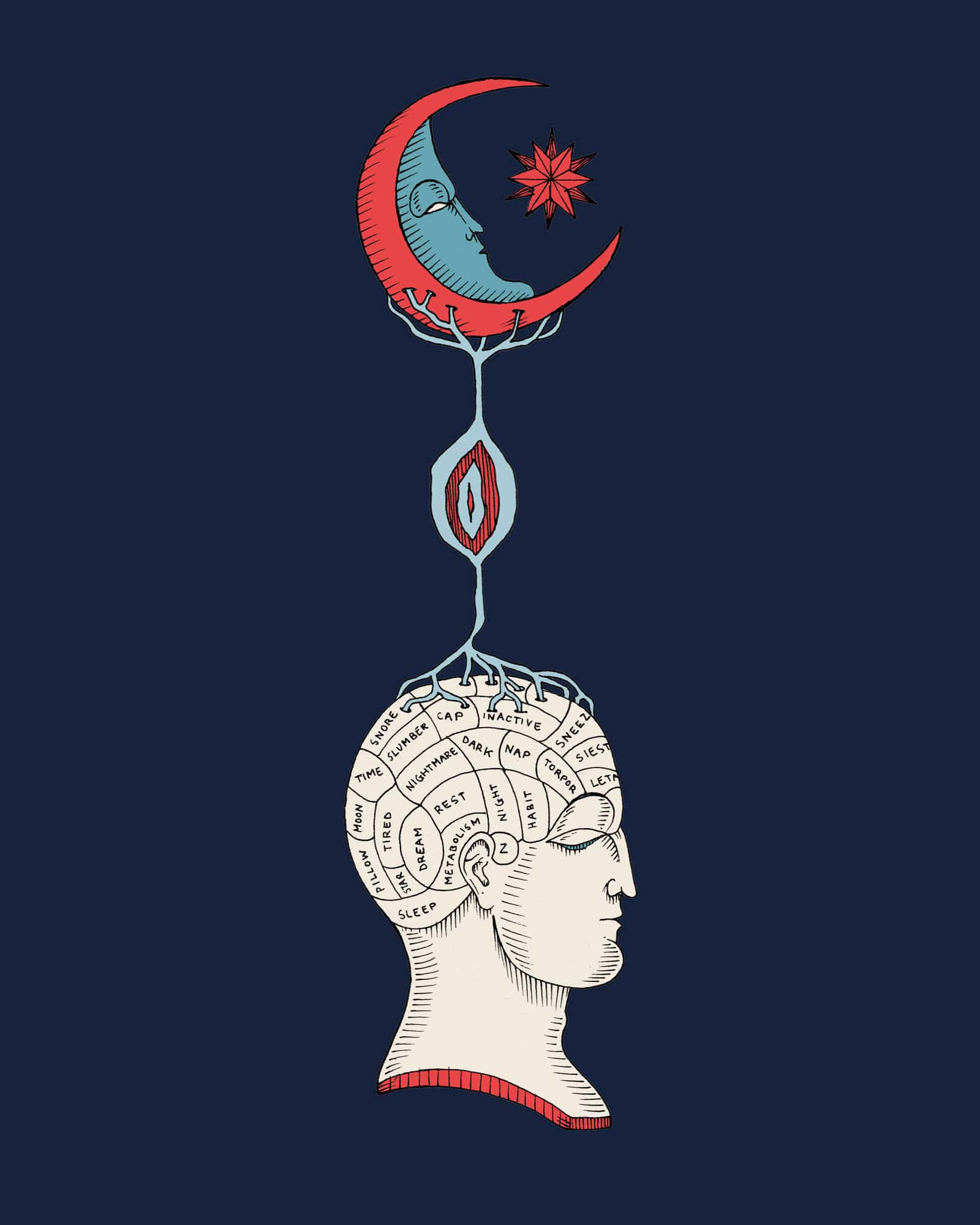The brain is ticking
There are various neural systems that allow for time keeping, and for our brains to make sense of time.
by Moran Cerf

While we think of time as one concept, the reality of it is that there are various versions of ‘time.’ One is what physics defines as the arrow that guides the movement of systems towards growing disorder (guided by the second law of thermodynamics), a different one that guides our brain in estimating the duration of events (when should we get tired, or feel hunger), and a third one, that we use when estimating experiences. We speak about these as if they are one concept, but the reality is that they are all different. Our reality is not anchored to any of them.
If we consider events in our life as continuous, we typically find it easier to use language that characterizes them as ‘moving forward’ in time. It allows us to organize and sort events chronologically and ground ourselves in reality in alignment with how memories are stories in our minds. However, given that the brain has to code time in memory as a sequence of discrete events, neuroscientists are often baffled by how we make sense of time in our mind. How does time affect our memory? How does our memory affect time? How do emotions alter our perception of an event’s length? And how can simple effects change our processing of time.
How our Brains Organize Time
Time is the way we, as humans, often organize events and coordinate. It is a useful idea that seems tangible and concrete. We can base it on repeated events and use them to synchronize the dynamics of our lives. Phases of the sun and moon, aging, menstrual cycles, all seem to follow a pattern that is predictable and structured. Time predicts when winter will come, when crops will grow, how fast things fall on the ground when we drop them. Big and small. All objects seem to flow within the magical arrow of time. It makes communication efficient and comfortable. Taking the world around us as a grounding cycle we have decided that a day is made of 24 hours, and those are divided into 60 minutes each.
These were arbitrary decisions. A day could have been 48 hours long. An hour could have been 100 minutes long. Nature does not mandate the parameters that we agreed upon for time measurement. As long as our perception and the sun align, we can deem one revolution of the sun as a certain number and define this one as a ‘day.’
But then again, it seems that our brain does have a specific clock, a counter, a metric by which it also code the movement of events. But does it? And does it align with the “clocks” that seem to rule the world around us?
The reality is that our brain does not carry any “clock” in it. It does, however, have various systems that allow for time keeping by monitoring the release of molecules and chemicals at specific periods which allow us to code time. If you are running out of certain chemicals, this is reflected in the system that, for example, tells you that you are hungry. Hunger is one way for the brain to tell time. Similar neural sites code your tiredness and mandate sleep. Similarly, they code your waking up and make sure you do not turn into a “sleeping beauty” who sleeps longer than they should (indeed, Sleeping Beauty is not just a kids’ tale, but actually a unique neural disorder where some people indeed demonstrate failure of the timing mechanisms thereby sleeping for much longer than expected).
External cues like the sunlight hours are used by our brain to calibrate our internal reliance on clocks. Indeed, the external world and us are one, in that time affects our brains and we can affect the movement of time in the world in a perfect interdependence. As relativity theory has shown, time itself is subjected to the laws of motion. We can slow down time by moving our bodies faster or slower. Individuals who travel faster in the world will age less than people who are stationary. Particles falling to earth from space, that should have decayed because their half-life is fractions of seconds, miraculously end up dropping to earth because their travel speed is so fast that they defy their life clock and manage to survive longer.

Our bodies are no different. They respond to the world and alter themselves in accordance with the world’s motion. In simple forms, distortion of the amount of sun seen by our eyes will create confusion in our brain, which manifests in the form of jet lag, and total deprivation of access to time cues may make us lose our anchors in reality. Indeed, prisoners who were sentenced to solitary confinement for longer periods have reported losing the ability to tell night from day, or the duration of events. They would fall asleep one day and, as they woke up, were not sure anymore if a full night had passed, or a short nap had occurred. The loss of grounding in time made them unable to know if they had been in confinement for hours or days and entirely lose their grasp on reality. A famous French experimenter tested this on himself when he confined himself to stay in a cave for what he perceived as 100 days. In a cringing memoir he reports the hallucinations and loss of ability to perceive himself as a living object when he lost the ability to tell the number of days that had passed. The brain does not favor those events and, accordingly, will often yearn for cues. If it cannot receive them, it will generate them internally. These are the roots of mental hallucinations that are commonly reported by people in solitary confinement.
Although the brain does not have this accurate, infallible clock residing in it, it does have many ways to tell time. One is by counting memories. Our brain often estimates the duration of experiences and codes events by the number of memories that were created. Studies in psychology have shown that a typical “moment” in a day (the time a person perceives as being in the “now,” carrying the same emotional state, perceiving as experience as simultaneous, coding things as passing through and leading to a future action before being ‘stored’), lasts about 1.5 seconds. This is the time it takes a brain to shift gears from naming an event “present” to “past.” Roughly every second and a half we move whatever happened before into the past in the form of a memory and start a new “present.” The brain takes snapshots of such second and a half events and keeps them as memories. Therefore, in one day we create, on average 57,000 nuggets of memories. In the absence of a clock — our brain deems such sequences of memories a unit of time.
Which means that we can alter our perception of time by altering the amount of memories created. If we experience events that generate more memories — we think they took longer. Fewer memories feel shorter.
Say, you are in a car accident. Your brain will often take rapid snapshots of all that happens while you slam the brake trying to prevent the accident from happening. In doing that it will sample reality and generate a larger number of memories — trying to take in as much information to protect you. People then often report following such accidents that they “remember every second.” They say they saw people’s faces, shocked expressions on other driver’s faces, views of the street where the accident occurred, and numerous details that required rapid sampling. All because the brain recognizes the importance of each and every moment and, accordingly, samples those. Many more memories are created in the span of [real] 1.5 seconds. And our brain therefore perceives the time as longer. Instead of having, say, 10 memories in 15 seconds, like we normally do, we may now have 30 in the span of the same time. And we will therefore perceive 1.5 second as 10 seconds.
More so, emotions seem to make us perceive time differently because they affect our memory. We remember more of emotional moments. And if memory is a way by which we code time, then emotional events seem longer and lead to more impressions. People know where they were on 9/11, because of the strong emotions associated with the day. Yet, you probably have no idea where you were on 9/10. You would think if you remember 9/11 you should be able to remember 9/10 as well, but the lack of emotion associated with 10th means that less memories were created. And with fewer memories, there is a lower likelihood that the time will be coded.

Fooling Time
Because the brain does not have a clock, we can also fool it into thinking that time is passing slowly or quickly with external cues. For example, I can make you think that time is dragging if you are experiencing something boring, or is speeding by if things are interesting. An hour of waiting for a bus to arrive could feel like two, whereas five hours with somebody you love could feel like a fraction of a second.
What is interesting though is that this can also be reversed. A study of experiences have shown that making a person believe that events took longer or shorter is affecting their joy of the event. Taking a clip by, say, Justin Bieber, that actually plays for two minutes, but rigging the YouTube counter and making it seem like the clip was longer (i.e., four minutes) made subjects then rate the clip as more enjoyable (“Wow. Four minutes felt so fast. I must have really enjoyed it. I should rate it higher”). Rigging the timer in the other direction — making the timer seem like it is running towards one minutes made participants rank the clip lower. “This one minute felt like twice as long. I guess it was really boring” their mind tells them.
Indeed, this mental time perception can be used as a tool to know whether events are joyous or not. I often tell my students to test this theory of time when they go on a date. When the date begins, they should secretly look at their watch and make a note of the time. After half an hour, they should ask the date: “How long do you think we have been sitting here?” If the date says it has “probably been 10 minutes,” and it has really been half an hour — you know things are going well. If they say 45 minutes, then you know there may not be a second date.

Individual Perceptions of Time
If you ask ten people about their perception of time, they are likely to differ in their coding of it. If you repeatedly ask them to tell the time without looking at a clock they are likely to not only err, but also err in a consistent manner. Some will always think events have been shorter and some longer. Simply, some of us are “over-shooters” and some under-shooters when it comes to using the clocks in our brain.
In an experiment we ran recently, we asked people to try to estimate the duration of short events. Were they one second long. 5 seconds, 4.5 seconds? Then we also asked people to try and start-stop a stopwatch at specific time windows of one second, two seconds, four seconds, and up to 10 seconds.
Some people seemed to always err in one direction and others in another.
However, to our amazement, this can be corrected in the experiment. We can shift your clocks. And as it turns out engaging content does this to us all the time. In miniscule numbers, but all the time. Having participants watch 10 minutes of boring content (a long-winded city council meeting for a small town in California) led all subjects to shift their clocks towards thinking things were slower than they were. Showing other groups engaging and rapidly-paced content (a chase scene from James Bond) made them then change their ability to start-stop a watch towards a faster speed. A change in boredom or interest will modify how we view time, and with it, our reality.
The brain, therefore, has to constantly account for those margins of error and correct them to afford accuracy and alignment with reality. It relies heavily on our senses in giving it the readings of the world that will allow for the coding of simultaneity and synchronicity. For example, the sixth sense that humans have called “Proprioception” is one where each organ in our body indicates to the brain repeatedly that it is “intact.” It constantly allows the brain to monitor the body and know where things are with each component. Tactile experiences are then used by the brain to estimate time as the brain remembers the distance from each organ and can estimate the travel time of body signals. For example, let’s say I clap my hands. The brain receives the tactile signal from both hands, presumably simultaneously. It also receives the auditory sounds of the clap that arrives in the ears. It may also see the clap using the eyes as photons that bounce on the retina from the hands. All of those signals approach different parts of the brain where they all travel at different distances and speeds, making various stops for various processing until they are bound together to become a real-time experience. The brain has to aggregate these signals to refer to them as simultaneous. Even though the signals are likely to arrive at the center of the brain at different times. The brain has to wait for the sound to be processed longer than to wait for the motion experience to arrive. Your brain is constantly waiting for information to deem events as “now.” Your eyes wait for your nose and your nose waits for your ears. The brain lives in a window of time where signals come from the senses and wait for others. If you tap your hand to your shoe, the story gets even more complicated as the signal from the leg will take much longer to arrive in the brain than the hand. As time scientists often jokingly say: “tall people seem to live in the past, because the taller you are the longer it takes for the conversion to happen from your feet to your brain.” If you are an NBA player, you live a little bit behind an ordinary person, because your brain has to constantly wait for more information. Presumably, the players compensate for this delay by speedy hyper-processing of signals that allow them to react faster than many of us. After all, their careers rise and fall by clocks that govern the game. The adage that says that “time is money” cannot be more true than in those rapid games.

Time Mistakes
Finally, some radical ideas about time may even lead to theories that could link the perception of time to chronic mental illnesses. One such theory that hovers in my circles of brain investigators suggests that flaws of our clocks may lead to the generation of altered thinking, as in the case of Schizophrenia — where a person might think they interact with a person that is not there. This could be explained by thinking of the conversations inside our heads as a series of events that happen in sequence. That is, when you ask yourself what to say in a future meeting you may create a conversation in your mind where you role play all the characters involved and consider what one may say to you, and what your answer may be. Typically, you have those internal conversations in a sequence that is ordered by the “timers” in your brain. However, if the system that organizes events in sequence is malfunctioning, the conversation may seem to be out of order. Answers may seem to come before a question was asked as the loss of timing may yield a loss of sequencing. As the brain does not know how to deal with answers that happen before a question, and as the notion of ‘before’ and ‘after’ is skewed, the brain will be quick to think that the answer came from an outside voice. The lack of generator for that voice may lead the brain to generate one — in the form of a character. For example, if you ask, what should I do? Should I go have lunch, or should I not? Typically, your mind will ask the question and then the answer will arrive. However, if the clock and the brain are misaligned, you might think of the answer before you asked the question, and the confusion will pave a road for a new person who must have asked the question — a new personality.
As such, these theories of time suggest that thoughts may alter time. This is key to many internal ruminations in our life. For example, in the form of dreams. Dreams, too, are often seen as time altering. A dream may last only minutes in ‘real time’ but the dreamer could perceive it as lasting hours, even decades.
In that sense, the perception of time, internally, is even more skewed. As all we can code as the past are our memories of it. And if we remember decades as brief moments — then this is all they are for us. Scientists studying the perception of time in dreams were able to show that some animals’ brains actually code time as moving faster during dreams, but in regular speed outside of the dream windows (but when the animal is still asleep). Rats who were placed in a maze when they were awake coded the entire maze in their brain like a map that emerged with a sequence of neurons activated whenever the rat approached a specific turn in the maze. When the rat was asleep, the same sequence fired — indicating that the rat is now replaying the maze experience in its sleeping brain. However, to many scientists’ surprise, in some moments the rat’s brain cells lit up backwards, and at double speed. As if the rat was replaying running through the maze in its dreams by rapidly moving in reverse order. Humans, too, show evidence of the ability to have different experiences of time in their brains. Some studies of lucid dreamers who could voluntarily move their closed eyelids while they were dreaming were used to test whether counting from 1 to 10 in the dream takes as much time as in the real world. This allows researchers to learn that, at least for lucid dreamers, time in the dream is mapped 1:1, to real time in the awake world. Despite people’s claims of different experiences of time.
Additionally, we can change our perception of time with psychoactive drugs that put people in a dream-like state. Those drugs may have different outcomes for different people, but they are frequently reported to change time perception. Some people claim that time is moving slower, for example, if they look at moving objects. Others say the opposite, feeling like they are talking rapidly. The drugs themselves seem to often target the chemical release of hormones in the brain that correspond to time perception, and therefore it is not surprising that their effect on perception is tied to the change in time. Aligned with our prior claims about the hallucinations that emerge when time is altered and even the potential connection to the brain’s generation of fictitious characters in schizophrenia, we can develop various plausible explanations about how our perception, emotion, memory, and time are interlinked and drive our experience of reality.
Animals and Time
Given the fascination that we have with time we can also turn to the animal world to learn about their perception of time and use that to understand our own experiences. Studies of animals’ time leads us to the idea that time is potentially coded in reverse in rats, but forward in humans. That time is counted by daylight hours — as many nocturnal animals sleep for many more hours than us humans during the day, and leads to various interpretations of the way the brain calibrates itself because of external cues. One example comes from the world of our beloved dogs. As recent works show, as soon as you leave the house your dog may have an experience of time and will know exactly how long you have been gone. It does so by counting the residue of molecules from your body that it smells in the air. Over time, more of your smell vanishes in the air and your puppy is able to keep count of “how much of you is still there” — how much it can smell you. And knowing internally, using its clock and the likely dissipation of molecules, it actually can tell how long you have been gone.
Given that a human lifespan is seven times that of a dog, the minutes you are gone to throw out the trash may feel like minutes to you, but hours for your puppy. Turtles who live to be hundreds of years old, may not notice your absence altogether, and may not be bored by the slow pace in which they move around the world. Maybe 100 human years feels like a brief moment for the turtle, and waiting for the bus, which feels like an eternity for us, is a miniscule anecdote for a turtle.
All of this is to suggest that despite feeling intuitive and natural, time may be an elusive and challenging entity for us to grasp. And its effect on our experience of life may be greater than we consider — on every given moment.



